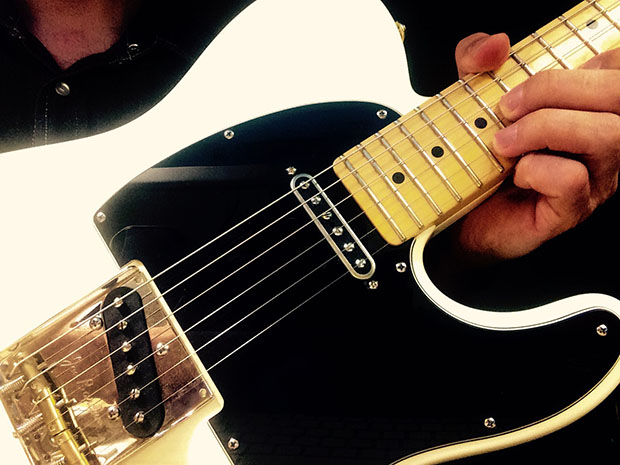Exploring Drop-D Tuning’s Unique Melodic Possibilities
Some cool things you can do with drop-D (with an emphasis on unusual melodic intervals).

In the Holiday 2014 and January 2015 installments of Metal for Life, I talked about the advantages of using drop-D tuning (low to high, D A D G B E) and demonstrated some cool things you can do with it.
This time I’d like to revisit this topic and show you some additional metal-style riffs played in this tuning, with an emphasis on unusual melodic intervals.
As I mentioned previously, drop-D tuning is great for metal because, along with the extended low range and resulting additional “heaviness” provided by the detuned sixth string, it enables one to conveniently fret power chords on the bottom two or three strings by simply barring one finger across the strings at any given fret.
FIGURE 1 is a fast-moving riff built around unison D notes played on the bottom two strings. With the index finger on C, on the A string’s third fret, I strum the bottom two strings then immediately hammer on to D at the fifth fret, The rhythmic syncopation of this figure is based on a “threes-on-fours” phrasing scheme played in even, or “straight,” eighth notes. This figure repeats in bar 2, then, in bar 3, the hammer-ons switch slightly, now moving from C#, on the A string’s fourth fret, to D at the fifth fret. In bar 4, I alternate between unison D octaves and single low D notes on the open sixth string.
Bars 5 and 6 utilize the same threes-on-fours phrasing scheme from bar 1, in this case to sound two-note Ab5 power chords at the sixth fret, which are pulled off to open D5 chords. The figures ends in bars 7 and 8 with some rhythmic “gallops”—an eighth note followed by two 16th notes—on the open low D string, followed by a hammer-on from an F5 chord to G5.
Another advantage of drop-D tuning is that it repositions the pitches on the sixth string, which can make it convenient to play unusual melodic patterns across the bottom two strings that would be difficult, if not impossible, to play in standard tuning. In FIGURE 2, a tritone interval (two notes three whole steps apart) is sounded by moving from D on the A string’s fifth fret to Ab at the sixth fret on the detuned bottom string. In standard tuning, that Ab note would be two frets lower, at the fourth fret. The resulting repositioning of the tritone fingering in drop-D tuning facilitates the execution of the unusual melodic phrase in bar 2 and also adds an interesting twist in the fretting in bar 4.
FIGURE 3 combines gallop rhythms with sliding strummed octaves and chromatically shifting two-note power chords. Beats one and three of bars 1 and 3 feature gallop rhythms played on the open low D string, which serves as a pedal tone.
On beats two and four of these bars, I play sliding strummed octaves, moving first from the fourth, G, down to the major third, F#, and then from the flat nine, or flat two, Eb, back up to the major third, F#. In bar 2, I alternate between an open D5 power chord on the bottom two strings and shifting octaves fretted on the A and G strings. The phrase then ends in bar 4 with chromatically moving two-note power chords on the bottom two strings that descend then ascend.

Get The Pick Newsletter
All the latest guitar news, interviews, lessons, reviews, deals and more, direct to your inbox!
“There are so many sounds to be discovered when you get away from using a pick”: Jared James Nichols shows you how to add “snap, crackle and pop” to your playing with banjo rolls and string snaps
Don't let chord inversions bamboozle you. It's simply the case of shuffling the notes around







![Joe Bonamassa [left] wears a deep blue suit and polka-dotted shirt and plays his green refin Strat; the late Irish blues legend Rory Gallagher [right] screams and inflicts some punishment on his heavily worn number one Stratocaster.](https://cdn.mos.cms.futurecdn.net/cw28h7UBcTVfTLs7p7eiLe.jpg)


